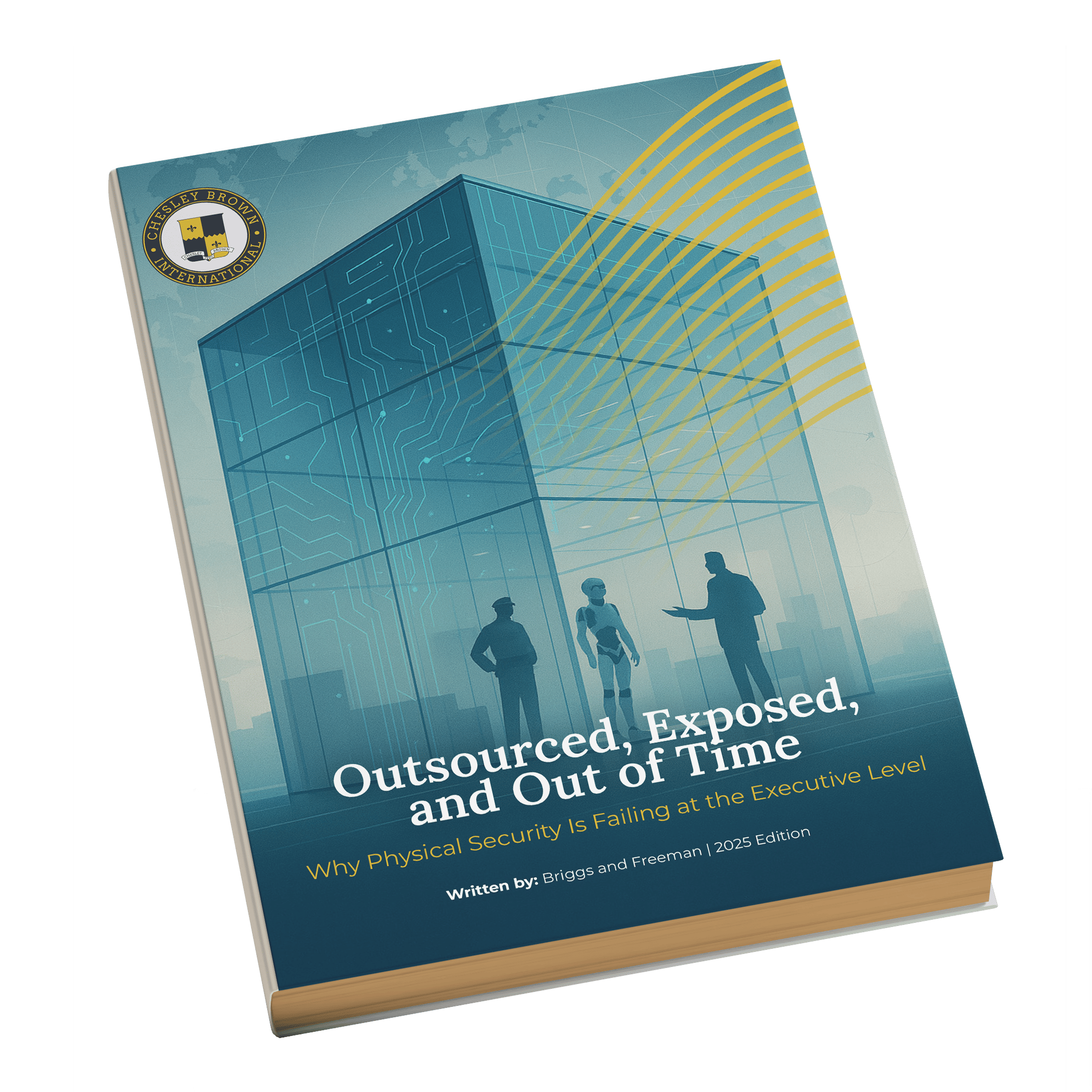Written by: James Hart
If your job requires you to talk to other human beings, then you could probably benefit from de-escalation training.
De-escalation is a conflict resolution strategy where security officers or other front-line workers use dialogue to calm angry individuals, understand their problems and persuade them to choose a better course of action. It’s become a go-to tool for both police departments and customer service representatives.
While heated conversations tend to get even hotter, de-escalation techniques try to lower the temperature so the underlying problem can be solved.
“What we really are discussing is the power of words, how we’re choosing to let words affect us,” said Josh Noland, vice president of western operations at Chesley Brown, the security management and consulting firm. “When we can stay in control of our emotions, we can stay in control of any situation.”
Noland provides de-escalation training to Chesley Brown’s security officers and a wide range of clients, including bartenders, property managers, doormen and others who might come face-to-face with hostile customers.
De-escalation isn’t always the best strategy. It’s probably not the best tactic to use during the middle of an assault, for example. But it can be extremely powerful for security officers, allowing them to take command of a situation without force.
After Louisville police adopted de-escalation training, the US Justice Department reported, use-of-force incidents there dropped by 28 percent. Injuries to citizens and officers declined, too – by 26% and 36%, respectively.
Not that you need to work in security or law enforcement to use this kind of training.
“Whether you work in a bank or you’re a telemarketer or a mechanic or a lifeguard,” Noland said, “there’s really no circumstance where learning how to calm yourself and stay in control of a situation wouldn’t be beneficial.”
The first person you have to help might be yourself
One of the first steps in de-escalation training is teaching individuals to control their emotions when a customer verbally attacks them.
That usually means profanity, and it can be hard to be cursed out and simply take it, Noland said. For most people, the natural instinct is to strike back.
“Most of the time, if someone just randomly starts yelling at you, your first response is surprise. Like, what did I do?” he said. “Your second response is anger. ‘I didn’t do anything. Why are you mad at me? Why are you yelling at me?’”
Instead of taking offense, security officers should ask themselves why someone is lashing out. Maybe that person is in a difficult situation that’s causing them to lash out. They might have been the victim of a crime. They might be worried about a loved one’s safety.
“They’re scared, they’re frustrated, they’re confused,” he said. “They could be trying to impress someone else.”
It can also help to examine the words that people are using. Again, if someone uses profanity, remember they don’t really know you, so it’s hard to take the attack seriously. Their language is just another outlet for their frustration and anger. Once security officers understand that, it’s easier to go to work on what’s really causing the problem.
“Why on earth would you ever for an instant believe that it was personal?” Noland said. “They don’t know you. They have no reason to hate you or even be angry with you.”
If a word is upsetting, he noted, it’s usually because of the opinions and emotions that we bring to it.
“I’m not going to allow a word to control me,” he said. “Instead, I’m going to focus on the actual problem and find a solution.”
Use conscious, empathetic communication
Once a security officer is calm and focused on finding a solution, what’s the next step in de-escalation?
“I’m going to ask appropriate questions in order to help them with their situation,” Noland said.
When someone is upset, they may forget details or make mistakes. Repeat back what you heard, so you can ensure that you understand them accurately. This demonstrates that you’re listening and that you want to help them.
While doing so, though, it’s important to be mindful about how you’re communicating. The wrong tone, the wrong word, even the wrong body language — they can all shut down any hopes of a productive conversation.
“How people say things can be just as impactful as what they actually say,” Noland said. “You can say a completely innocent sentence. But if you say it with the wrong tone, you know, someone’s going to think you’re being a jerk or you’re being sarcastic or you’re mocking them.”
So speak a little more slowly. Avoid raising or lowering your voice, and be careful about tone or emphasis. Give the other person your full attention and listen to them as they speak.
Instead of standing directly in front of someone, stand to the side and respect their personal space — give them a few feet. Don’t touch them. Avoid literally pointing fingers.
Instead of giving orders, making demands or issuing ultimatums, make a point of asking if they will do something. Otherwise, you’ll be setting yourself up for a power struggle. It’s also important to show courtesy — “please” and “thank you” really are magic words.
It’s also important to pay attention to the person’s emotions. Acknowledge what they’re feeling without judgment. Don’t say you “know how they feel,” though. Instead, it may be more appropriate to say: “That must feel frustrating / scary / irritating.” Never, ever tell someone to “calm down.”
A smile is one of the best ways to comfort people, but be careful how you use it. For example, it could backfire if they are crying and it comes across like you’re smiling because it’s funny.
How long does it take to learn de-escalation techniques?
While it takes practice, Noland said, a lot of de-escalation behaviors are common sense. In fact, many people already use them instinctively.
“What I like to say is if you’ve ever been successful talking to anyone ever and getting them to do what you want them to do,” Noland said, “you already have some of these skills.”
The training helps because it puts a name on these behaviors and helps security officers remember when to use them.
What de-escalation training looks like in action
There are so many real-life situations where de-escalation training can be used to create a better outcome, Noland said.
A security officer might be trying to help someone whose car has just been broken into. That person could be so upset that getting useful information from them is almost impossible.
But an officer trained in de-escalation training would know how to approach them and redirect them to the problem at hand. That way, security can learn if any cameras picked up the theft or if the customer has a description of the thief.
“We forget about how much time we spend in our cars and how that kind of becomes a safe space for us,” Noland said. “When someone violates that safe space, it can truly be traumatic. but we need visitors to be able to communicate with us so that we can investigate it.”
Or maybe a visitor is denied access to an office building because they don’t have the right ID or their name isn’t on a list of preapproved guests. Using a de-escalation technique, security officers can instead refocus the visitor and try to help them find some other solution.
“Who is the person you’re trying to contact?” Noland said. “Maybe we can call them. Do you have an email? Do you have any other information? Let’s reach out to them, and maybe you can find some other way to get what you need.”
It can even help when dealing with one of the most challenging types of customers: the intoxicated person who got kicked out of a bar or restaurant. By showing them someone is trying to help — by retrieving their credit card from the bar or helping them find their friends or a ride home — security helps direct them away from more bad behavior.
The bottom line about de-escalation techniques
The best security teams are problem-solvers. De-escalation techniques increase an officer’s ability to reach beyond a customer or visitor’s anger and frustration, so the officer can more effectively address the underlying issue without getting sidetracked by arguments and blowups.
It’s just a matter of taking time to slow down and communicate more thoughtfully.
“I think it makes them a better officer,” Noland said. “I also think being able to keep control of yourself and temper your anger or your frustration, that’s just going to make you a better human being, too. It’s going to make you happier when you don’t take every little thing personally.”
De-escalation training is just one service in Chesley Brown’s comprehensive suite of security and investigative solutions. To learn more about the training or any other service, contact the firm today.
Sign up!
For industry-leading guides and analysis sign up for our blog below.
Latest News
Election Day: Planning for Civil Unrest
Protecting your business in the event of election day civil unrest requires planning. Here we discuss four proven strategies for Civil Unrest
The Transformational Power of Threat Assessments
Ignoring Risk won’t make it go away Cyber crime is one of the most insidious threats facing businesses. As reported here, more than 50% of businesses have suffered cyber attacks–70% of them being small to…
3 Practical Strategies to Protect Your Small Business During Covid-19
October 15, 2020 / Justin Hayes Ensure the Future of Your Company Small to medium-sized enterprises (SMEs) comprise a massive portion of American industry. In fact, 99% of all businesses have less than 500 employees;…
The Anatomy of a Crisis Management Plan
4 key strategies to protect your business against risk By Justin Hayes No executive expects a crisis to strike. But every day organizations fall prey to the unforeseen. One study found that 40% of businesses…
risk-takers #9. Joe Sheram – The Turnaround Guru
Brent sits down with corporate turnaround expert Joe Sheram to discuss financial risk, corporate theft, the importance of cash, and some of the biggest challenges businesses face when navigating a crisis from a financial perspective. Joe has helped countless organizations restructure, and strategize their way through some of the most complex and serious issues a business can face.







